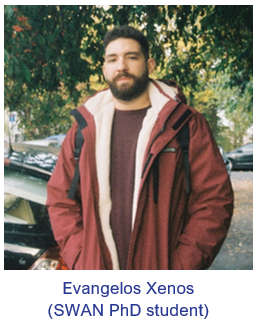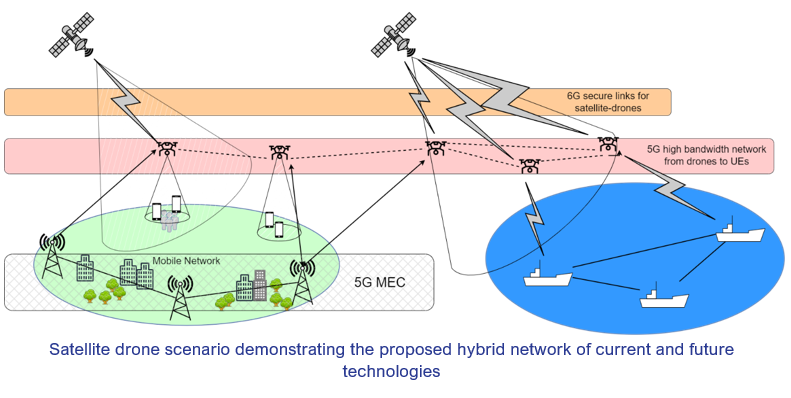In the latest blog in our ‘spotlight on research’ series, we caught up with Evangelos Xenos, one of the two PhD students on the EPSRC-funded SWAN studentship. Now a year into his studies, Evangelos is beginning to build out his research project and is gathering data on his hybrid network architecture using various modelling techniques. We asked Evangelos a few questions about his project and the work he has done so far on communications security for hybrid Unmanned Aerial Vehicles (UAVs) and autonomous 5G and 6G networks.
 What is the key focus of your PhD and how does this relate to SWAN?
What is the key focus of your PhD and how does this relate to SWAN?
I am focusing on how UAVs and Internet of Things (IoT) technologies can be integrated within 5G networks to enable a higher communication efficiency, robustness, and enhanced security. I am also investigating how current technologies could be further improved by creating new network architectures for future applications.
Part of my research will be dedicated to investigating collaborative communications between UAVs (e.g. satellites and terrestrial communication networks), by exploiting current and future technologies 5G networks provide such as Multiple-access Edge Computing (MEC) and Internet of Things. In addition, I will be evaluating current applications and methods implemented in current communication systems to measure security, resilience, and robustness in severe demand for service scenarios.
Wireless communication networks are expanding at tremendous rates nowadays and the need for secure and ubiquitous connection is apparent. The proposed method would add an extra layer of security separate from the one the core network provides. This research feeds directly into SWAN’s key aim to develop wireless system architectures that are more resilient and more secure.
Can you give us a brief overview of the work you have been doing recently?
I have been designing and modelling how a hybrid network architecture of current and future technologies would significantly improve terrestrial connectivity and security capabilities by utilizing technologies like UAVs and MEC for extending coverage and computation power.
What will be the key outputs of this particular piece of work?
We will have a model on which we will be able to put together different communication scenarios and technologies and inspect how each sector affects the rest. This will enable us to be able to adjust and have the full view of how the rest of the network is improved and study how behaviours change.
 What are the next steps for this section of your research?
What are the next steps for this section of your research?
I will be implementing some physical layer security approaches mentioned in other research papers (e.g. Tang, Chen & Coon, 2019 "Secrecy Performance Analysis of Wireless Communications in the Presence of UAV Jammer and Randomly Located UAV Eavesdroppers") to see how my network behaves.
Can you tell us of one recent publication in the world of communications systems and networks research that has interested you?
Thantharate, A. Beard, C. & Kankariya, P. ‘CoAP and MQTT Based Models to Deliver Software and Security Updates to IoT Devices over the Air,’ IEEE iThings/GreenCom/CPSCom/SmartData, 2019, pp. 1065-1070
This paper is investigating the security issues “over the air updates” are facing for autonomous cars and IoT systems and how these can be addressed and dealt with more efficiently. It compares some current methods for constrained systems and applications on how to deliver security patches to nodes based on their needs securely, based on their operating scope
Is there anything else you would like to tell us?
It is exciting being part of the Communication Systems and Network group within the University and interacting with so many people every day. The ideas and expertise exchanged, and the bonds created are something that not only helps me develop in professional level but in personal too. It has proved to be a very wise choice.
SWAN Prosperity Partnership
SWAN is an EPSRC Prosperity Partnership project dedicated to the creation of Secure Wireless Agile Networks (SWAN) that are resilient to both cyber attacks and accidental or induced failures. The partnership is made up of contributors from the Smart Internet Lab at the University of Bristol, Toshiba Research Europe Ltd, GCHQ, and Roke Manor Research Ltd.
Interested in reading more about SWAN and our programme of research? Take a look at our website for more information or for regular updates on SWAN activities and opportunities to get involved.
